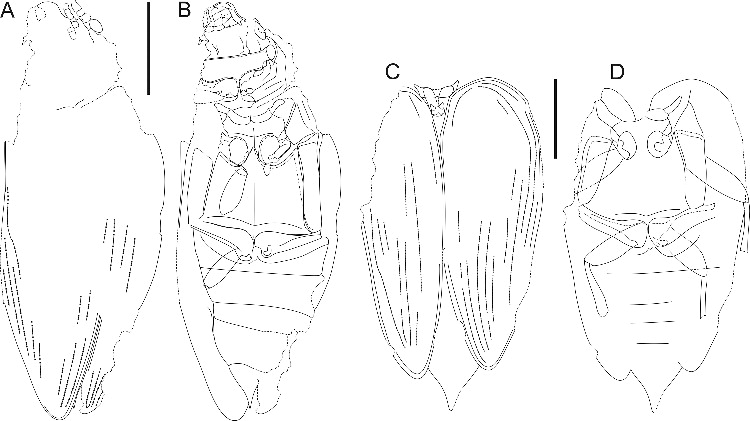@WFS,World Fossil Society,Riffin T Sajeev,Russel T Sajeev
He’s Australian, around half a centimetre long, fairly nondescript, 300 million years old, and he’s currently causing astonishment among both entomologists and palaeontologists. The discovery of a beetle from the late Permian period, when even the dinosaurs had not yet appeared on the scene, is throwing a completely new light on the earliest developments in this group of insects. The reconstruction and interpretation of the characteristics of Ponomarenkia belmonthensis was achieved by Prof. Dr Rolf Beutel and Dr Evgeny V. Yan of Friedrich Schiller University Jena (Germany). They have published this discovery together with beetle researcher Dr John Lawrence and Australian geologist Dr Robert Beattie in the current issue of the Journal of Systematic Palaeontology. It was Beattie who discovered the only two known fossilised specimens of the beetle in former marshland in Belmont, Australia.

Habitus photos of †Ponomarenkia belmonthensis sp. nov. A, B, holotype 40278; C, paratype 41618. Scale bars = 1 mm.
“Beetles, which with nearly 400,000 described species today make up almost one-third of all known organisms, still lived a rather shadowy and cryptic existence in the Permian period,” explains Jena zoologist Beutel. “The fossils known to date have all belonged to an ancestral beetle lineage, with species preferring narrow spaces under bark of coniferous trees. They exhibit a whole series of primitive characteristics, such as wing cases (elytra) that had not yet become completely hardened or a body surface densely covered with small tubercles.”

Line drawings of †Ponomarenkia belmonthensis sp. nov. A, B, holotype; C, D, paratype. Scale bars = 1 mm.
Earliest form of the modern beetle
In contrast, the species that has now been discovered, assigned to the newly introduced family Ponomarenkiidae, can be identified as a modern beetle, in spite of its remarkable age. Modern characteristics are the antennae resembling a string of beads, antennal grooves, and the unusually narrow abdomen, tapering to a point. What is more, unlike previously known Permian beetles, the wing cases are completely hardened, the body’s surface is largely smooth, and the thoracic segments responsible for locomotion show modern features, notes insect palaeontologist Yan. In addition, it appears that this little beetle had stopped living under tree bark, the habitat favoured by its contemporaries, and had adopted a much more exposed lifestyle on plants. A significant fact is that, due to its unorthodox combination of ancestral and modern characteristics, this genus does not fit in any of the four suborders of beetles that still exist, which is why Yan and Beutel have given it the nickname Bad Boy. “Ponomarenkia belmonthensis shows above all that the first major events of radiation in the evolution of beetles took place before the Permian-Triassic mass extinction,” says Rolf Beutel. Beetles as a whole survived this dramatic event, which saw the acidification of the seas and major volcanic eruptions, considerably better than most other groups of organisms, presumably because of their terrestrial life style and hardened exoskeleton. However, the Bad Boy ran out of luck, as there are no more traces of its existence in the Mesozoic era.
Name honours eminent palaeontologist
The Jena researchers dedicated the genus and family to Moscow palaeontologist Prof. Alexander G. Ponomarenko. He has had a strong influence on beetle palaeontology for decades and supervised Dr Evgeny V. Yan’s doctorate. Yan obtained his doctorate from the Russian Academy of Sciences, spent five years as a postdoc at the Chinese Academy of Sciences in Nanjing, and since June 2016 he has done research at the Institute of Systematic Zoology and Evolutionary Biology with Phyletic Museum of the University of Jena as a guest researcher funded by the Alexander von Humboldt Foundation. It is Yan’s elaborate reconstructions on the computer that have provided the precise insights into Ponomarenkia belmonthensis.
In the first stage, some 40 photographs were taken of the two specimens, which were available as impressions on stone. “With this series of photographs an accurate 2D reconstruction was possible, with which we were able to correct for deformations in the original fossil. This allowed us to get closer to the actual beetle,” explains Dr Yan. Based on precise drawings and with the help of a special computer program that is also used for animation and computer games, a very informative 3D model was created. “The 3D reconstruction also enables us to draw conclusions about the way the beetle moved and lived,” the palaeontologist adds. He has developed this method of visualisation, as well as the analytical process in which he also includes hypothetical ancestors of the beetle, since his arrival in Jena. “We have already been able to apply this process to three newly discovered ancient beetle species,” Prof. Beutel is happy to report. “In this way, we have made significant steps towards deciphering the earliest stages in the evolution of an extremely successful genus of animals.”
@WFS,World Fossil Society,Riffin T Sajeev,Russel T Sajeev
Citation:Friedrich-Schiller-Universitaet Jena. “300 million-year-old ‘modern’ beetle from Australia reconstructed.” ScienceDaily. ScienceDaily, 24 July 2017. <www.sciencedaily.com/releases/2017/07/170724105041.htm>



 July 25th, 2017
July 25th, 2017  Riffin
Riffin  Posted in
Posted in  Tags:
Tags: 